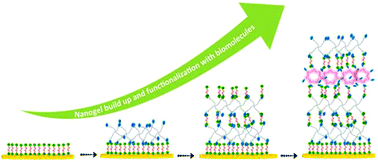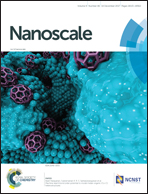Step-by-step build-up of covalent poly(ethylene oxide) nanogel films†
Abstract
Hydrogels based on poly(ethylene glycol) (PEG) are commonly used for studies related to cell fate and tissue engineering. Here we present a new covalent layer-by-layer build-up process leading to PEG coatings of nanometer size called “nanogel films”. Compared to macroscopic hydrogels, such nanogels should provide a fine control over the structure and the thickness of the coating. Alternated deposition of bifunctional and tetra functional PEG molecules reacting through thiol/maleimide click chemistry is evaluated by quartz crystal microbalance. We first study parameters influencing the build-up process of such coatings and demonstrate the importance of (i) the nature of the first deposited layer, (ii) the PEG concentrations and (iii) the length of the PEG chains that appears to be the most significant parameter influencing film growth. The build-up process can be extended to a large variety of substrates like SiO2 or polymers by using an appropriate anchoring layer. Covalent functionalization of these nanogel films by proteins or enzymes is suited by modifying the biomolecules with thiol or maleimide groups and immobilizing them during the build-up process. Activity of the embedded enzymes can be maintained. Moreover ligands like biotin can be incorporated into the film and recognition by streptavidin can be modulated by playing with the number of PEG layers covering biotin. Compared to well-known PEG hydrogels, these new coatings are promising as they allow to (i) build thin nanometric coatings, (ii) finely control the amount of deposited PEG and (iii) organize the position of the embedded biomolecules inside the film layers.



 Please wait while we load your content...
Please wait while we load your content...